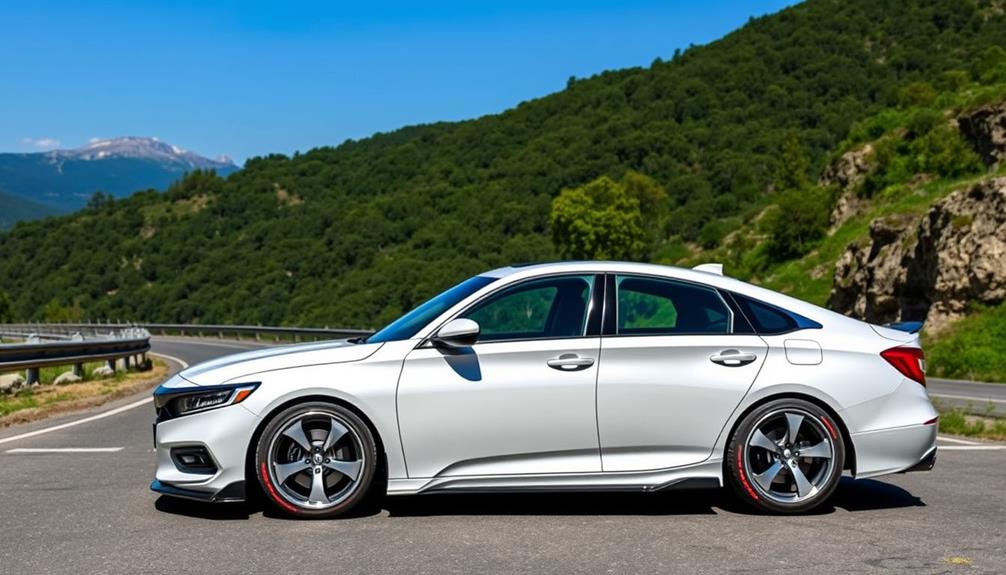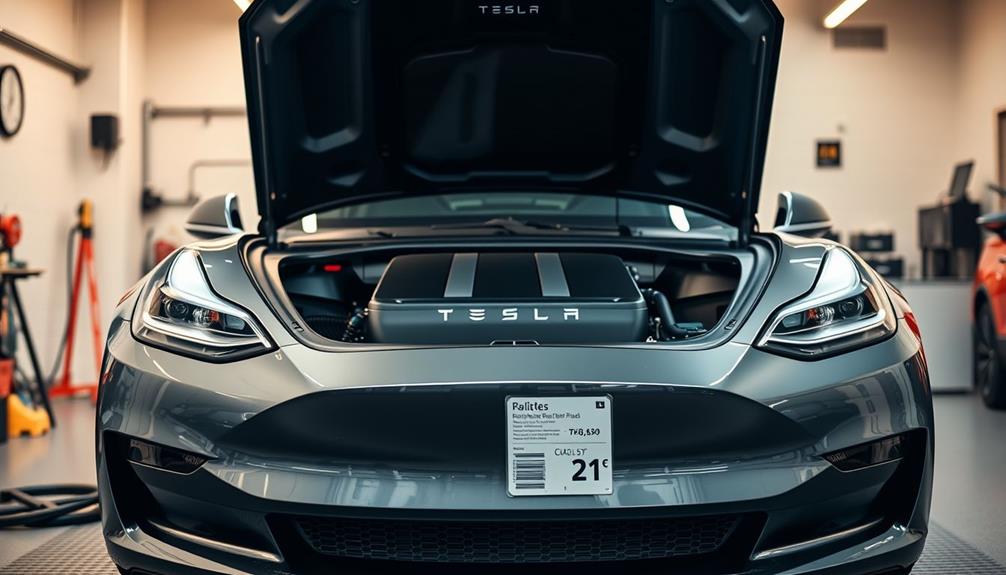Tesla's full charge range varies by model. The Model S Long Range can take you up to 405 miles. The Model 3 Long Range offers about 358 miles, while the Performance version of Model Y provides around 303 miles. Factors like your driving style, speed, and environmental conditions can impact these figures. Aggressive driving and extreme temperatures can greatly reduce how far you can go. To maximize your range, consider smooth driving habits and monitor your energy usage. There's much more to discover about optimizing your Tesla's performance and charging options.
Key Takeaways
- The Tesla Model S offers the highest range, up to 405 miles per charge with the Long Range version.
- The Model 3 can achieve up to 358 miles in its Long Range variant, while the Standard version offers 267 miles.
- Model Y's Performance version provides around 303 miles, with the Standard model offering 244 miles of range.
- Real-world range may vary due to driving habits, aggressive acceleration, and environmental factors like cold temperatures.
- Charging options, such as Superchargers and Wall Connectors, enable quick recharging to extend driving distances during trips.
Understanding Tesla Battery Range

When it comes to understanding Tesla battery range, you'll find that each model offers unique capabilities. The Model S leads the pack with an impressive estimated range of up to 405 miles per charge, while the Model 3 follows closely at 358 miles. The Model Y Performance provides a solid range of 303 miles.
However, keep in mind that these figures are based on EPA test data and can vary based on your driving pattern and environmental conditions.
Your Tesla's range can fluctuate greatly, especially in cold temperatures. In fact, frigid weather can reduce battery efficiency, increasing energy usage by about 6%. Factors like your driving style, speed, and even the terrain you encounter also play a role in how far you can go on a single charge. Additionally, using climate control systems can further impact the range.
To help you monitor your energy usage, Tesla provides the Energy app on your vehicle's touchscreen. This tool allows you to track your energy consumption while driving and parked, ensuring you have a better grasp on your electric vehicle's range capabilities.
Factors Affecting Driving Distance

Several factors can greatly impact how far you can drive your Tesla on a full charge. One major element is the Tesla model you choose, with the Model S offering a maximum range of up to 405 miles and the Model 3 providing up to 358 miles.
Your driving style also plays a vital role; aggressive acceleration and high speeds can markedly reduce your range per hour.
Terrain is another significant factor—driving uphill requires more energy, decreasing your overall mileage compared to flat surfaces.
Additionally, environmental conditions can affect battery life; extreme temperatures, especially cold weather, can drastically reduce your driving distance.
It's essential to take into account that real-world mileage may differ from EPA estimates due to personal habits, like using climate control or other energy-consuming features.
If you want to maximize your full charge, you should adjust your driving style, be mindful of the terrain, and keep an eye on the weather.
Tesla Models and Their Ranges

When you look at Tesla models, you'll notice significant differences in their range capabilities.
For instance, the Model S Long Range can go up to 405 miles, while the Model 3 varies based on its version.
It's important to think about how your driving habits and environmental factors can influence these ranges as well.
Model-Specific Range Differences
Have you ever wondered how the range of different Tesla models compares? Understanding the mileage ranges of each Tesla vehicle helps you choose the right one for your needs. Here's a quick overview of the range you can expect from various Tesla models:
| Tesla Model | Maximum Range (miles) |
|---|---|
| Model S Long Range | 405 |
| Model 3 (Standard) | 267 |
| Model 3 (Long Range) | 358 |
| Model Y Performance | 303 |
| Model Y (Standard) | 244 |
The Tesla Model S Long Range leads with an impressive 405 miles of range per charge, thanks to its larger battery capacity. The Model 3 offers a versatile range, peaking at 358 miles, while its standard model achieves 267 miles. The Model Y Performance provides around 303 miles, making it a solid choice for families.
Keep in mind that real-world mileage can vary due to factors like driving habits and climate control. With Tesla's extensive network of charging stations, you can confidently explore the open road without worrying too much about range anxiety.
Factors Affecting Range
While Tesla vehicles are known for their impressive range, several factors can influence how far you can actually drive on a single charge. Each model has a different range based on its specifications—like the Model 3 reaching up to 358 miles and the Model S Long Range achieving 405 miles. However, your actual mileage range can vary considerably in real-world conditions.
Driving habits play an essential role; aggressive acceleration and high speeds can drain your Tesla battery faster. Terrain also matters—hilly roads can increase energy consumption. Additionally, using climate control features like heating or air conditioning can further impact range, especially in cold weather, where studies show a potential decrease of 20% or more in efficiency.
To maximize your driving distance, make certain you're operating at peak efficiency by regularly monitoring your energy consumption through Tesla's Energy app.
Keep in mind that charging habits, battery health, and even tire pressure can affect performance. By understanding these factors, you can better plan your trips and make the most of your Tesla's capabilities.
Charging Options and Times
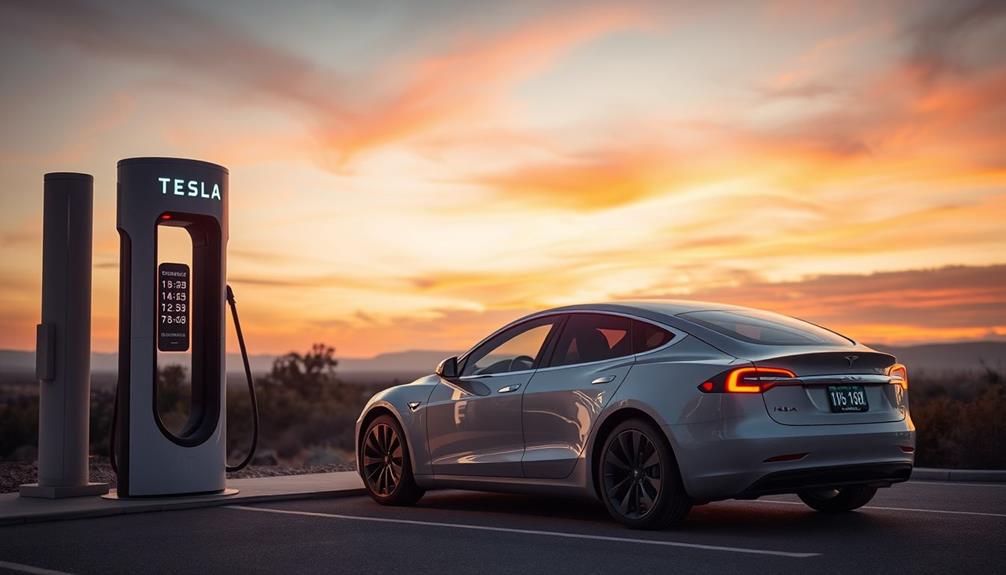
Efficiency in charging is essential for Tesla owners, especially those who frequently travel long distances. With various charging options available, you can keep your EV battery charged and maximize your battery range. Here's a quick overview of your charging choices:
| Charging Option | Range Added (miles per hour) | Time to Charge (20% to 80%) |
|---|---|---|
| Supercharger | 150-200 | < 30 minutes |
| Wall Connector | Up to 44 | Overnight (8 hours) |
| Standard Outlet | 2-3 | Several days |
When you're on the road, Tesla's Superchargers are ideal, adding 150-200 miles of range in under 30 minutes. For home charging, a Wall Connector can give you up to 44 miles per hour, allowing you to wake up with your vehicle charged and ready. If you're using a standard wall outlet, expect the slowest charging option, providing just 2-3 miles per hour. By understanding these options, you can choose the best way to charge your Tesla and guarantee you're always ready for your next adventure.
Benefits of Solar Charging
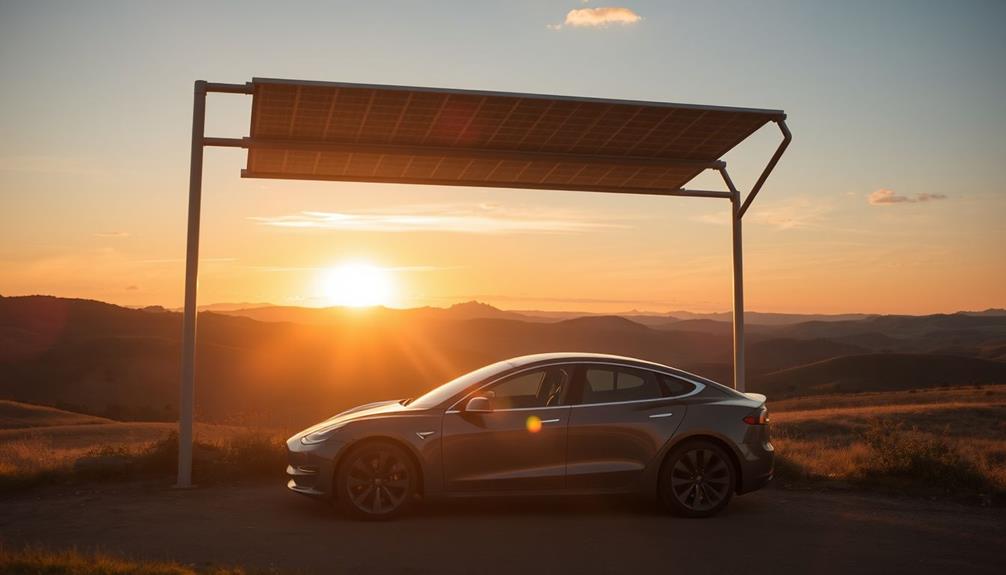
When you opt for solar charging, you release significant cost savings and reduce your environmental impact.
By generating your own emissions-free electricity, you can cut your annual charging costs dramatically compared to public stations.
Plus, this sustainable choice supports a greener future for everyone.
Cost Savings Potential
Harnessing solar energy for charging your Tesla can lead to remarkable cost savings. When you use solar panels, you can charge a Tesla for as low as $219 annually, compared to around $1,134 per year at public charging stations. This results in significant savings over time, especially for Tesla owners who appreciate the financial advantages of electric vehicles. Additionally, pairing solar energy with your Tesla not only reduces reliance on the grid but also minimizes your environmental footprint. For potential buyers researching Tesla car price details, factoring in long-term charging savings with solar energy can make the investment even more appealing. This combination of sustainability and cost-efficiency underscores the value of transitioning to clean energy solutions.
Consider these key benefits:
- Lower Charging Costs: Solar charging drastically reduces your yearly expenses per vehicle.
- Break-Even Period: With an average break-even period of 7.5 years for solar panel investment, the long-term savings become apparent.
- Incentives: Homeowners can access various financial incentives for shifting to solar energy, further boosting savings.
- Zero-Emission Charging: Using solar energy eliminates your reliance on grid electricity, allowing you to charge your vehicle with emissions-free power.
Environmental Impact Reduction
Charging your Tesla with solar energy not only saves you money but also makes a considerable positive impact on the environment. By installing home solar panels, you can generate emissions-free electricity that powers your EV, reducing your dependence on fossil fuels. This approach not only lowers your annual charging costs to as low as $219 but also promotes a zero-emission lifestyle.
Here's a quick comparison of charging options:
| Charging Method | Annual Costs | Environmental Impact |
|---|---|---|
| Home Solar | $219 | Emissions-free electricity |
| Public Charging Stations | $1,134 | High fossil fuel reliance |
| Traditional Electricity | Varies | Dependent on source |
| Solar Panel Lifespan | 25+ years | Long-term sustainability |
The average break-even period for solar investment is around 7.5 years. After this, the savings on charging costs accumulate considerably. Additionally, the battery's ability to store solar energy guarantees that you can maintain this eco-friendly charging method for a long time, making it a wise choice for both your wallet and the planet.
Tips for Maximizing Range
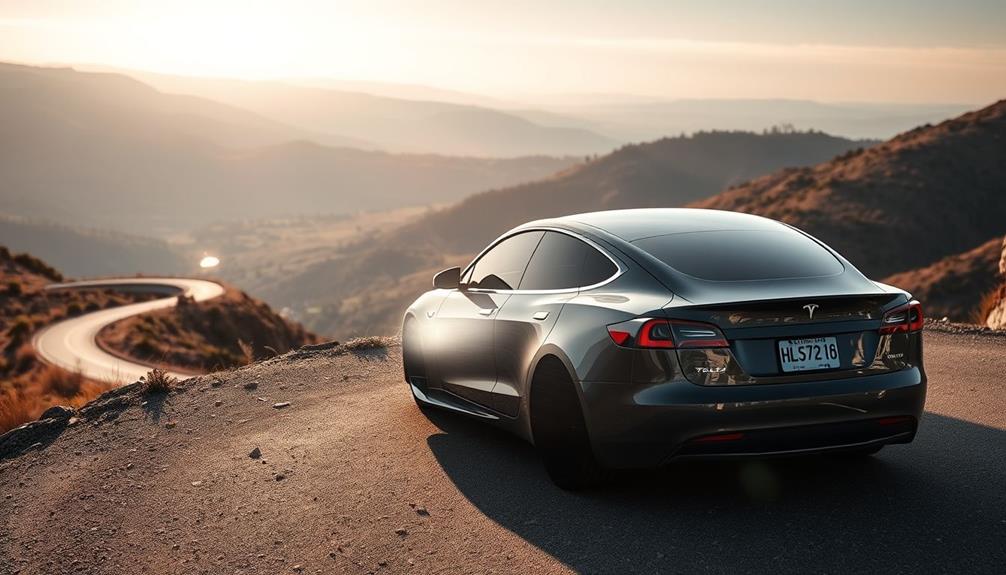
Maximizing your Tesla's range is a practical goal that can enhance your driving experience and ease range anxiety. With the right strategies, you can improve your electric car's efficiency and get the most out of your Tesla car batteries.
Here are some tips to help you maximize range:
- Smooth Driving: Gradual acceleration and braking reduce energy consumption. Avoid aggressive driving habits that can diminish your battery's ability to last longer.
- Utilize the Energy App: Use the vehicle touchscreen to monitor energy usage in real-time. Identifying patterns helps you make adjustments to maximize your lithium-ion battery's performance.
- Precondition Your Vehicle: Plug in your Tesla before driving, especially during cold weather. This retains battery heat, optimizing energy use despite outside temperature challenges.
- Maintain Tire Pressure: Regularly check and maintain proper tire pressure. Additionally, reduce unnecessary weight in your vehicle to enhance range performance during road trips.
Frequently Asked Questions
How Long Does It Take to Charge a Tesla at a Public Charging Station?
When you charge a Tesla at a public station, it typically takes about 30 minutes to reach 80% at a Supercharger. For slower options, expect around one hour for about 44 miles of range.
How Far Can You Drive With a Fully Charged Tesla?
Imagine zooming across the country without a care. With a fully charged Tesla, you can travel up to 405 miles, depending on the model. Just remember, real-world conditions can impact your adventure's distance.
How Far Can a Tesla Go on a Full Charge at 75 Mph?
At 75 mph, you can expect a Tesla to cover between 250 to 375 miles on a full charge, depending on the model. Just remember, real-world conditions might impact that range considerably.
How Far Does a Full Charge on a Tesla Last?
Wondering how far a full charge on a Tesla lasts? Depending on the model, you could go between 303 to 405 miles, but factors like driving style and weather can impact that range considerably.
Conclusion
In the world of electric vehicles, Tesla stands out like a beacon of innovation. By understanding your Tesla's battery range and the factors that influence it, you can make the most of every charge. With various models offering impressive distances and charging options at your fingertips, you'll be ready for any adventure. Embracing solar charging can further enhance your journey, ensuring you travel farther while reducing your carbon footprint. So, gear up and hit the road with confidence!

